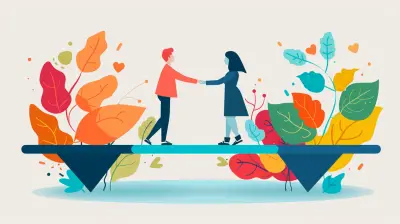The Intersection of Collaboration and Innovation in Education
28 May 2025
Education is no longer just about memorizing facts and acing tests. It’s about learning, growing, and preparing for a world that keeps changing. And guess what? The best way to do that is through collaboration and innovation.
Teachers, students, and even technology are coming together in exciting new ways to reshape education. But how exactly does collaboration fuel innovation? And why does it matter so much? Let’s dive into this fascinating blend of teamwork and creativity in the classroom.

The Power of Collaboration in Education
Collaboration is like the secret sauce of education. When students work together, they think critically, solve problems, and learn from each other’s perspectives. And when teachers collaborate, they bring fresh ideas and strategies to the table, making learning more effective.1. Collaboration Among Students
Ever noticed how brainstorming with friends leads to better ideas? That’s exactly how collaboration works in learning. When students work together, they:- Develop communication skills – Sharing thoughts, debating ideas, and presenting arguments.
- Enhance critical thinking – Challenging each other’s viewpoints sharpens problem-solving abilities.
- Boost creativity – Collective thinking leads to more creative ideas than working alone.
- Build teamwork skills – A vital ability for any future job.
Think about a group project. One student may be great at research, another at presenting, and another at organizing ideas. By working together, they create something stronger than what they could have done alone.
2. Collaboration Among Teachers
Teachers, too, thrive when they collaborate. When educators share lesson plans, teaching strategies, and classroom experiences, they enhance learning outcomes for students. Some benefits include:- Improved teaching methods through shared best practices.
- Stronger support systems by learning from one another’s experiences.
- Better student engagement by incorporating new ideas adapted from colleagues.
Many schools encourage Professional Learning Communities (PLCs), where teachers come together to analyze student performances and brainstorm strategies to improve learning. When teachers collaborate, students win!
3. Collaboration Between Schools and Communities
Learning doesn’t just happen within school walls. Partnerships with local businesses, technology firms, and community organizations open up fantastic opportunities for students. Internships, mentorships, and real-world projects can transform education from theory into practice.
Innovation: The Driving Force of Modern Education
Now, where does innovation fit in? Imagine education as an old dusty book. Innovation is the fresh breeze that flips the pages, rewriting outdated approaches and introducing new ways of thinking.1. Technology as an Innovation Game-Changer
With technology, education has moved beyond textbooks and whiteboards. We now have:- Online learning platforms like Coursera and Khan Academy offering courses to anyone, anywhere.
- Virtual Reality (VR) and Augmented Reality (AR) making history and science come alive.
- Gamification that turns learning into an engaging and rewarding experience.
- Artificial Intelligence (AI) helping tailor lessons based on individual student needs.
With digital tools, students can learn at their own pace and teachers can personalize education to better support each learner.
2. Project-Based Learning (PBL) and Blended Learning
Traditional learning methods often focus purely on academics. But what if students learned by solving real-world problems? Project-Based Learning (PBL) does exactly that—it encourages students to work on meaningful projects that require creativity, research, and teamwork.Similarly, Blended Learning combines online and in-person learning, giving students flexibility and control over their educational paths.
3. Encouraging a Growth Mindset Through Innovation
Innovation also changes how we think about failure. Instead of fearing mistakes, students in innovative classrooms see them as learning opportunities. A growth mindset fosters resilience, determination, and a love for learning.
Where Collaboration Meets Innovation
Now, here’s the magic: when collaboration and innovation come together, education transforms into an interactive, student-centered experience.1. Collaborative Innovation in the Classroom
Think of a science class where students use robotics and coding to solve real-world problems. They work together, brainstorm ideas, experiment, and eventually create something groundbreaking. That’s collaborative innovation in action!Apps like Google Classroom, Padlet, and Trello take teamwork to the next level. Students collaborate on projects in real-time, regardless of where they are.
2. Teachers as Innovators
Teachers aren’t just educators; they’re innovators shaping the future of learning. Some methods making a difference include:- Flipped Classrooms – Instead of traditional lectures, students watch lessons at home and discuss/apply them in class.
- Experiential Learning – Hands-on experiences like science experiments, field trips, and simulations reinforce theories.
- Interdisciplinary Learning – Merging subjects (like science and art) to develop a broader understanding.
3. Global Collaboration for a Brighter Future
With the internet, learning isn’t isolated to one classroom or country anymore. Students connect with peers from around the world to exchange ideas, experiences, and solutions. Global collaboration encourages tolerance, diversity, and cross-cultural understanding.
Challenges and Overcoming Them
Of course, every great idea comes with challenges. Some common roadblocks in fostering collaboration and innovation include:- Resistance to change – Some educators may find it challenging to adopt new methods.
- Technology barriers – Not all students have equal access to digital tools.
- Lack of training – Teachers need guidance to integrate new strategies effectively.
However, with patience, continuous learning, and support from educational leaders, these challenges can be overcome. Schools must provide teacher training, invest in technology, and encourage a culture of adaptability.
Final Thoughts
The intersection of collaboration and innovation in education is reshaping how students learn, think, and prepare for the future. When students, teachers, and communities collaborate, and when creativity meets technology, education becomes dynamic, engaging, and impactful.The future of education isn’t about memorizing facts—it’s about discovering solutions, thinking outside the box, and working together to solve real-world challenges. And that’s the kind of learning that truly lasts.
all images in this post were generated using AI tools
Category:
CollaborationAuthor:

Bethany Hudson
Discussion
rate this article
3 comments
Juliet McNeely
Collaboration and innovation in education are like two sides of a coin, each enhancing the other. When diverse minds unite, they spark creativity and question the status quo, transforming learning into a dynamic process. Embracing this synergy is essential for cultivating future-ready thinkers.
June 16, 2025 at 3:16 AM

Bethany Hudson
Thank you for highlighting the vital connection between collaboration and innovation in education. Your insights underscore how diverse perspectives can indeed drive transformative learning experiences for future thinkers.
Tia Conrad
Where minds unite, ideas ignite—collaboration kindles innovation's flame, shaping futures bright.
June 3, 2025 at 4:14 AM

Bethany Hudson
Thank you! Collaboration truly fosters creativity and propels innovation in education, paving the way for a brighter future.
Sheena Webster
This article sparks intrigue! It's fascinating how collaboration can drive innovation and reshape the educational landscape. Excited to learn more!
May 31, 2025 at 4:05 AM

Bethany Hudson
Thank you! I'm glad you found it intriguing. Collaboration truly is key to transforming education. Stay tuned for more insights!



